As readers familiar with the Arthurian legends know, there is no one single "official" account. The medieval versions vary widely, giving modern retellers a great deal of freedom in choosing an approach. Sir Thomas Malory's Le Morte D'Arthur remains the best known traditional version for modern English-speaking audiences, and many modern versions owe some debt to this work.
Some of the comics in this section follow one or more traditional versions of the legends fairly closely, though often expurgating material thought to be inappropriate for a young audience, or otherwise abridging the vast and complex body of medieval Arthurian literature to present a more concise narrative of the rise and fall of Arthur and his kingdom. Others concentrate on one particular legend or episode and elaborate upon it, offering original details not included in any extant medieval text. Finally, a few of these comics stretch the very definition of a "retelling," presenting Arthurian characters and events in a non-traditional setting, such as the 19th century American West, or a contemporary middle school.
Written by Lereculey, illustrated by Chauvel. Nine volumes published by Delcourt, 1999-2006: Myrddin
le
Fou (in English, Mad Merlin); Arthur
le Combattant
(Arthur the Soldier); Gwalchmei le Heros
(Gawain the
Hero); Kulhwch et Olwen (Culhwch
and Olwen),
Drystan et Esyllt (Tristan and Isolde),
Gereint et
Enid (Gereint and Enid), Peredur le Naif ,Gwenhwyfar
la
Guerrière (Guinevere the Warrior),
and Medrawt
le Traitre (Mordred the Treacherous). Welsh and English translations of the first two installments were published as a single volume (English title: Arthur the Legend) in 2009 by Dalen Books.
This new retelling opens in AD 500, in a Britain divided between Kymry and Lloegrians. Merlin finds an orphan and raises him to change the destiny of the British people. (Sources for French publication: Bedetheque and French Wikipedia.)
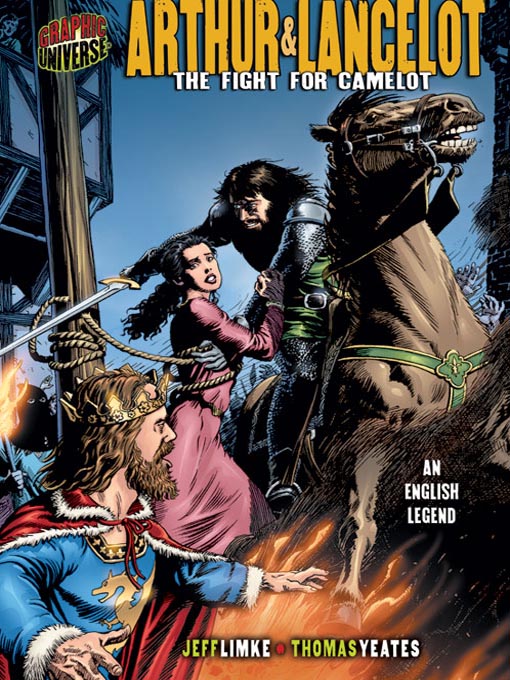
French, reprinted in Dutch as Arthur in het
Legendarisch
Koninkrijk.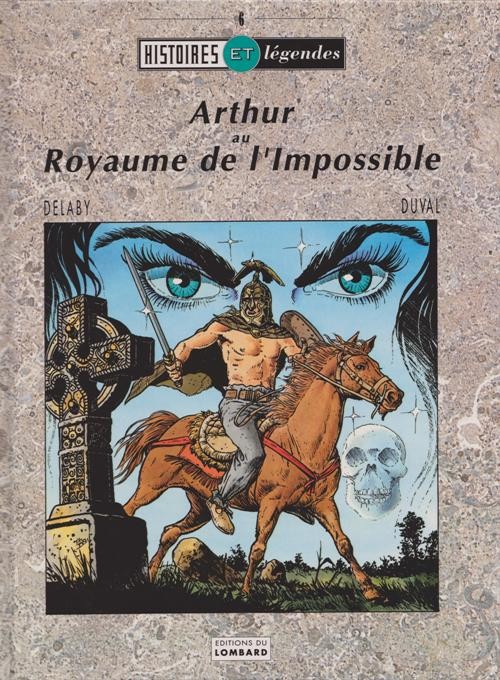
Written by Yves Duval, illustrated by Philippe Delaby. Originally published in the magazine Tintin, 1987-1991; collected edition published by Lombard.
Robert Vermaat writes: "Yves Duval and illustrator Philippe Delaby have created one of the best Arthurian comics that I know of. In five short stories... they follow the Arthurian legend through the ages in several versions, from a Welsh legend to a medieval saga, [then] the fifth one (the 'truth' about King Arthur) [which] is as historical as possible. Each story is illustrated in the style of time in which it was told - very original! The single fault I could find is the French background (Mont-Bandon?)."
Written and illustrated by Michael Fraley. 5 issues, black and white, Tome Press (a division of Caliber Press), 1993 -1994.
This miniseries is a close adaptation of the story of Arthur as presented by Geoffrey of Monmouth in his History of the Kings of Britain (circa 1140), the first complete account of Arthur's life and career, which predates Malory by over 300 years. Fraley's version begins with Arthur's conception and ends with his departure for Avalon.
Online publication, 2004-2014, at http://www.arthurkingoftimeandspace.com.
Paul Gadzikowski produced this "webcomic" in daily installments from May 22, 2004 through January 6, 2014. As he describes the premise in the strip's FAQ: "When King Arthur drew the sword Excalibur from the stone, its magic proved more powerful than even Merlin had known. It unmoored Arthur and his contemporaries from their home time, so that sometimes they exist in their original time, and sometimes they exist in the far future, and sometimes they exist in our time, etc." The major time periods depicted include a traditional Malory-like setting, a futuristic space setting, and a contemporary setting in which Arthur is an American high school student. The non-traditional settings help move this strip into its own special category, somewhere between a retelling and a new story of the traditional characters.
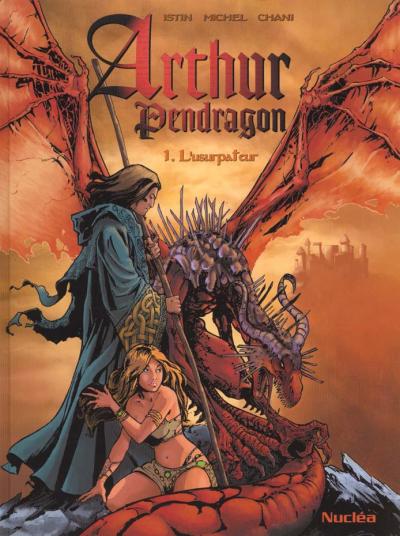
French
Written by Jean-Luc Istin, illustrated by Michel. First volume, L'Usurpateur (The Usurper), published in 2001 by Nuclea.
Istin continues his chronicle of the Arthurian age begun in his Merlin series. (Source: Bedetheque.)
Original country and language of publication uncertain.
Illustrator and original author unknown. English dialogue by Steve Miller. "Originally published by Editorial Astri, S.A." This version published as Arthur Sex in 8 issues, black and white, by Aircel Comics (a division of Malibu Graphics Publishing Group), 1991. Later reprinted in two four-issue series, Camelot Uncensored and King Arthur Uncensored. (Sources for reprint information: an Arthurnet posting by Michael Torregrossa and the Mile High Comics Internet Store.)
Subtitled "The Erotic Adventures of King Arthur", this is a sexually explicit retelling of episodes from the Morte D'Arthur.
Written by Sam Sarkar, illustrated by Garrie Gastonny.
Radical Publishing, 2008. 5-issue miniseries
collected in trade paperback as Caliber: First Canon of
Justice, 2008.
This
unconventional retelling of the Arthurian legend reframes the story as an
American Western, set in the Pacific Northwest of the 19th century.
In this version, Excalibur is a magical six-shooter that
never misses, but only when drawn by a man with justice on his side.
Arthur Pendergon is a young man seeking to reclaim the estate
of his father Ulysses; he is aided in his quest by the
half-French, half-Native American shaman Whitefeather, the gunslinger
Lance Lake, and others.
(Note: In an interview
with Comic
Book Resources,
Sarkar indicated that in his conception, the gun Caliber is made from
the metal of the original sword Excalibur, and that the weapon (and by
extension, its bearer) resurfaces through history. If this concept is
developed in any future series installments, Caliber could ultimately belong more correctly
to Part
Two
of this survey.)
Written by Jeff Limke, illustrated by Rob Davis. One issue, black and white. Arrow Comics Group, 2001.
The final battle between the forces of King Arthur and his son Medraut is retold from the perspective of Sir Bedwyr's squire, Evynn. The text introduction to the comic book states that the creators plan future original tales of Evynn (who becomes the last Knight of the Round Table) in post-Arthurian Britain.
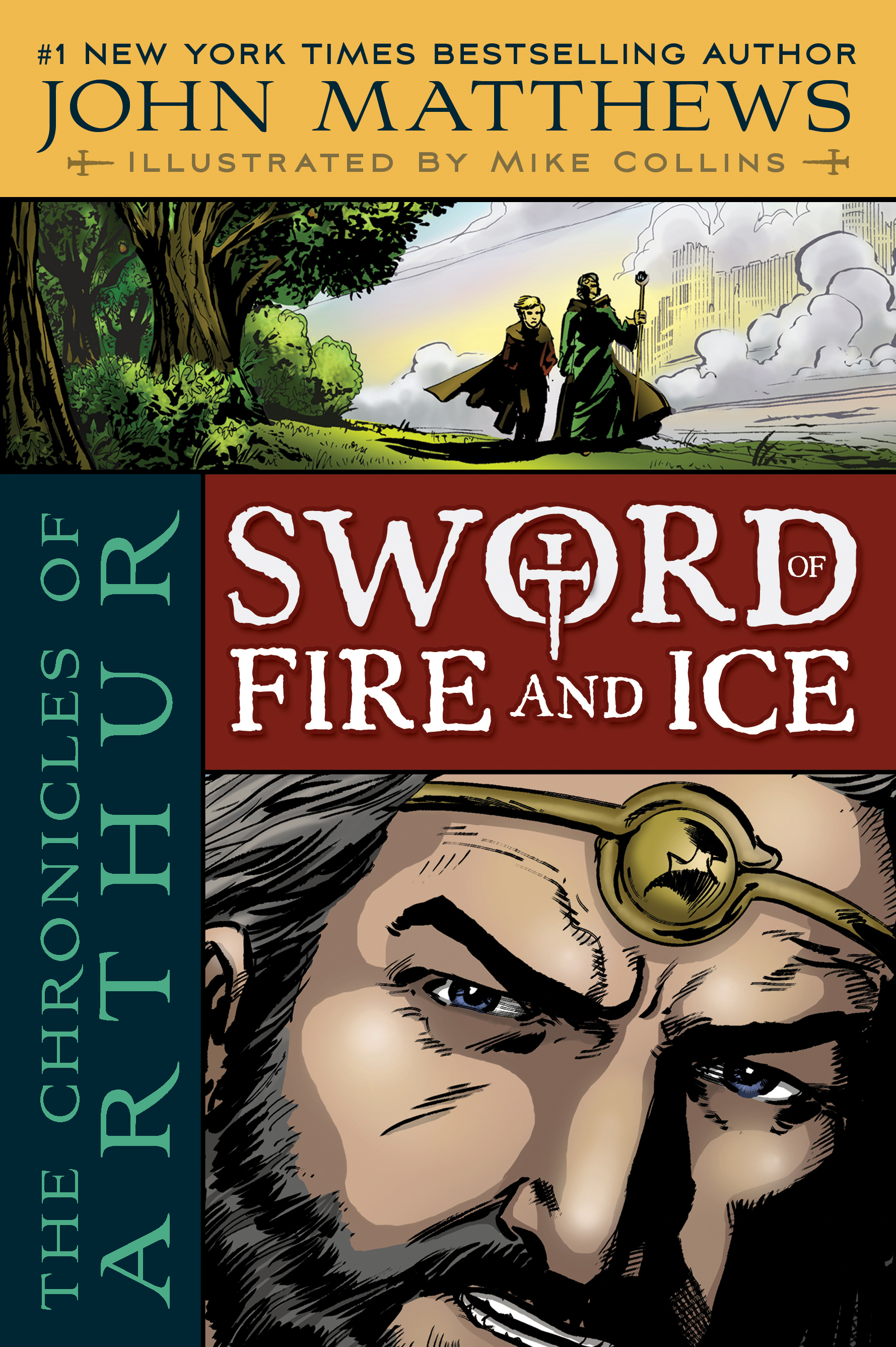
Written by John Matthews, illustrated by Mike Collins. Published by Aladdin (Simon & Schuster), 2009.
This graphic novel for young readers follows in the tradition of T. H. White's The Sword in the Stone by elaborating on the sparse traditional accounts of Arthur's boyhood. The writer, a prolific author of what may be termed "New Age" Arthuriana, incorporates characters drawn from elsewhere in Arthurian and Celtic legend -- such as the Green Knight, the Questing Beast, and Arawn, the Lord of Annwn -- into his tale of Arthur's upbringing in Avalon and his tutoring by Merlin. (A couple of years following the publication of this volume, Matthews returned to the subject to provide a more traditional account of Arthur's early career in Le Morte d'Arthur : the Legend of King Arthur and his Knights of the Round Table.)
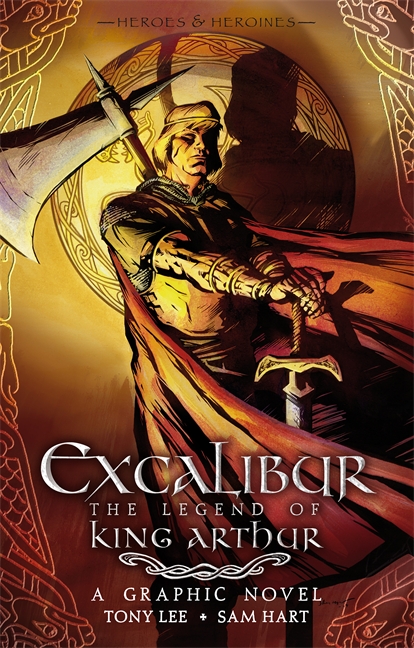 Written by Tony Lee, illustrated by Sam Hart. Published by Candlewick Press, 2011.
Written by Tony Lee, illustrated by Sam Hart. Published by Candlewick Press, 2011.Italian. Translated into Dutch as De Jeugdjaren van Koning Arthur.
Written by Mario N. Leone. Illustrated by Gino D'Antonio. Originally published in the comic magazine Il Vittorioso, 1957-58. (Source for Italian title and publication information: Daniel Nastali.)
Robert Vermaat writes: "This less-than-perfect work... looks very much like an adaptation of T. H. White's The Sword in the Stone, but draws on late medieval sources as well. The young Arthur, fostered by Sir Hector and his son Kay, is constantly harassed by omens and the evil intentions of the evil King Uriel and his wife Morgana, until the great tournament in London, where Merlin reveals Arthur's right to the throne."

French. Translated into Dutch as De Koningsstrijders (in English, The King's Warriors)
Written by Patrick Cothias, illustrated by Michel Rouge. 6 vols. (Perd-Cheval; La Grande Ourse; Mark de Cornwall; Esprit de Vermine; Blanche Fleur; La Faim des Illusions). Published by Glenat, 1987-1997. (Source of French publication information: Bedetheque.)
Robert Vermaat writes: "Patrick Cothias and illustrator Michel Rouge, famous for their historical scenarios, have set this Arthurian adventure in the middle of the sixth century. The hero, Kern ab Frog, is kept hidden by his mother in the woods to escape military service. When he comes across the Green Man of the Woods (the savage Merlin) and Arthur's knights chasing him, his world changes abruptly. In the first volume, ('Perd Cheval', 1987) he reaches Arthur's court and receives a name. In the second volume (1990), Parsifal (as he is now called) has to evade the soldiers sent after him by his enemy, Kay... even though the story is written from a French angle (Mark of Cornwall is the real noble hero, whereas Arthur is a warring barbarian), the historical elements look mostly correct."
For another comics treatment of the Perceval legend, see the entry for P. Craig Russell's adaptation of Richard Wagner's Parsifal.
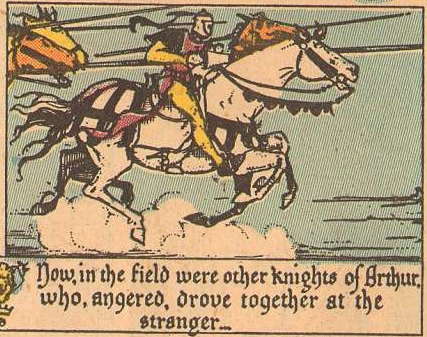
Written and illustrated by Rafael Astarita, DC Comics, 1936.
Daniel Nastali provides this annotation: "This is a retelling of the
central Arthurian story, ultimately derived from Malory, in two-page
black and white segments by one of the most accomplished of the early
artists providing original work for comic books. As in Foster's "Prince Valiant",
which would appear a year after Astarita's first episode, text and
dialogue are placed beneath the pictures. The six parts were
republished together in color in Atomic Comics #1, 1946." Astarita also drew (and possibly wrote) another Arthurian feature, "Round Table Adventures", discussed in Part Two.
(Thanks also to Steven M. Bergson for a helpful e-mail tip.)
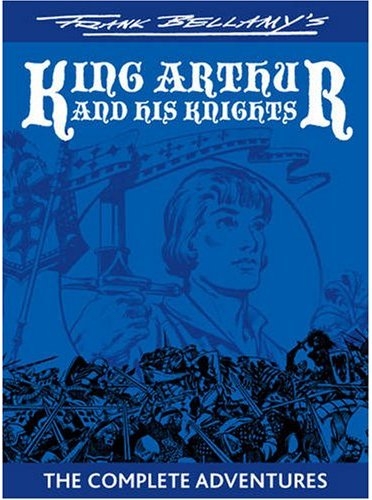 Written
by Clifford Makins, illustrated by Frank Bellamy. Originally
published in 41 installments in the British weekly comics paper Swift,
July 30,
1955 - May 5, 1956. Collected in a trade paperback edition in 2008.
Written
by Clifford Makins, illustrated by Frank Bellamy. Originally
published in 41 installments in the British weekly comics paper Swift,
July 30,
1955 - May 5, 1956. Collected in a trade paperback edition in 2008.
This unusual retelling of the legend collapses Arthur's reign into a very brief period. Mordred's machinations to overthrow Arthur begin almost as soon as he is crowned, and Lancelot has barely established himself at Camelot before Mordred and his ally Agravaine trick Arthur into believing him a traitor. The storyline quickly proceeds to the familiar last chapters of the traditional tale, with the usual tragic ending somewhat softened. Perhaps reflecting a "boy's adventure story" approach to the material, neither Guinevere nor any other significant female character makes an appearance. The series is most successful on a visual level, featuring vigorous black-and-white illustrations by the well-regarded British artist Frank Bellamy.
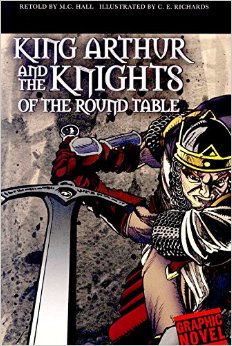 King
Arthur and the Knights of the Round Table (Stone Arch)
King
Arthur and the Knights of the Round Table (Stone Arch)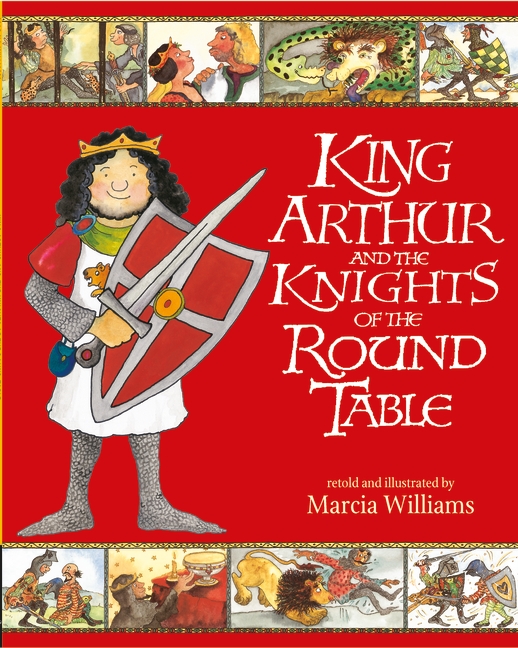
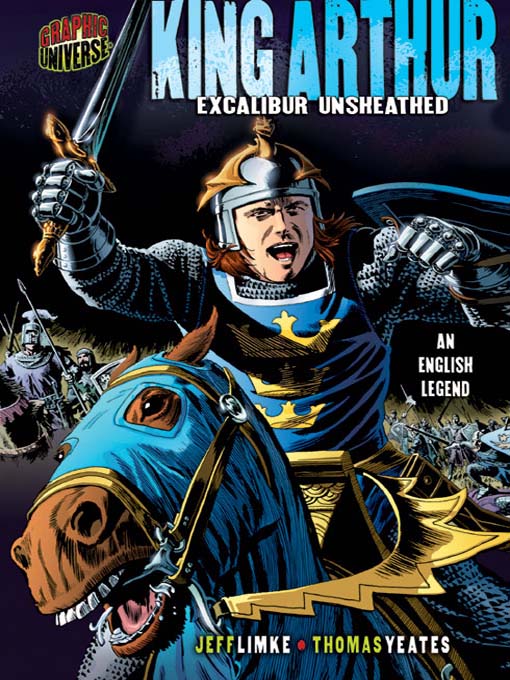
Written by Jeff Limke, illustrated by Tom Yeates. Published by
Graphic Universe (Lerner Publishing Group), 2006.
This 48-page graphic novel, freely adapted from Malory's "The Tale of King Arthur," retells the story of the early years of Arthur's reign for readers aged 9 to 12. A sequel from the same creators, Arthur & Lancelot: The Fight for Camelot, was published by Graphic Universe in 2007, as was a retelling of the Tristan and Isolde legend, also written by Limke.
(Both the author and illustrator worked with Arthurian materials previously; Limke in Camelot's Last Knight Camlann and Legends of Camelot, and Yeates in Swamp Thing #87.)
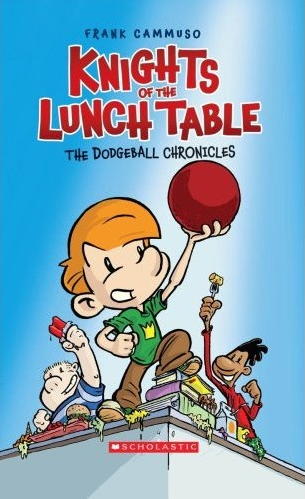
Written and illustrated by Frank Cammuso. Published by Graphix (Scholastic Inc.), 2008 to 2011.
Frank Cammuso's series of comedic graphic novels for young readers places Arthurian characters and situations in a contemporary American setting. Artie King is a student at Camelot Middle School; his best friends are Percy, Wayne, and Gwen, his mean sister is Morgan, and Mr. Merlyn is his science teacher and faculty advisor. In the first volume, The Dodgeball Chronicles, Artie discovers that he is able to open a locker that no other student has been able to open, making him "king" of the school. A second volume, The Dragon Players, appeared in 2009, and a third, The Battling Bands, in 2011.
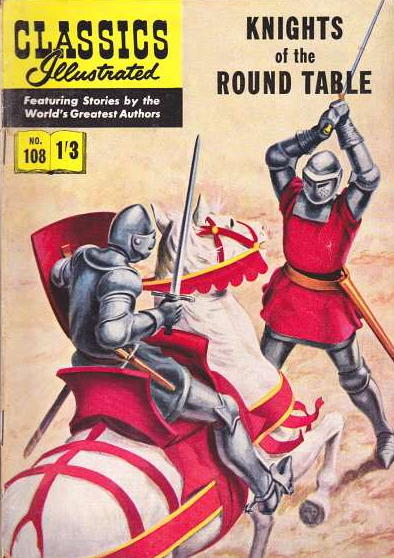
Illustrated by Alex Blum. 1953.
A retelling based on Malory, reprinted various times (including in foreign editions --Robert Vermaat reports a Dutch edition dated 1972 entitled De Ridders van de Tafelronde.)
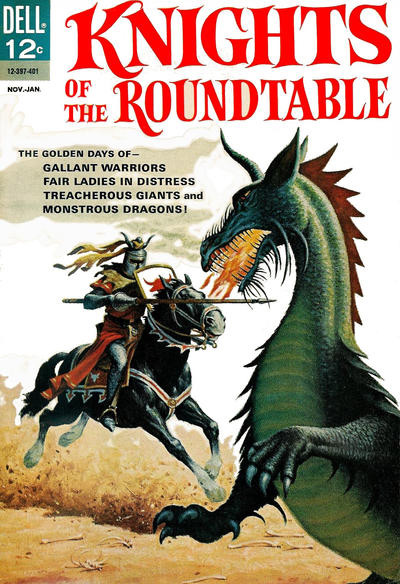 One issue, Dell Publishing Co., 1964.
One issue, Dell Publishing Co., 1964.
This uncredited one-shot (not to be confused with the Dell adaptation of the1954 film of the same name) chronicles the story of King Arthur from the last years of the reign of Uther through the wedding of Arthur and Guinevere. The publisher may have intended to continue the story in further issues.
Written (or "compiled") by Joe Martin, illustrated by various. One issue, black and white. Tome Press (a division of Caliber Comics), 1998.
Not actually a comic story, but a series of text pages profiling Arthur and his knights with accompanying full-page illustrations. Joe Martin later edited and wrote an installment for Caliber's Legends of Camelot series of one-shots.
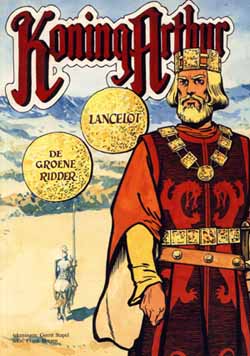
Dutch.
Robert Vermaat writes: "This completely Dutch comic by illustrator Gerrit Stapel and Frank Herzen, otherwise known from children's novels and scientific publications on Welsh Arthurian sources, was supposed to have been the first of about twenty albums. A drop in the sale of the Taptoe, a magazine for young adults unfortunately prevented this.
"This single album (1986) in black-and-white consists of two short stories (of the originally planned 53) about Lancelot (unknown, dealing with Modred) and the Green Knight (the classic tale). The illustrations picture twelfth-century Norman knighthood, as the main sources for the script were Geoffrey of Monmouth and Thomas Malory. Very enlightening are the interviews with both writer and illustrator. These stories appeared in Taptoe in 1980's publications."
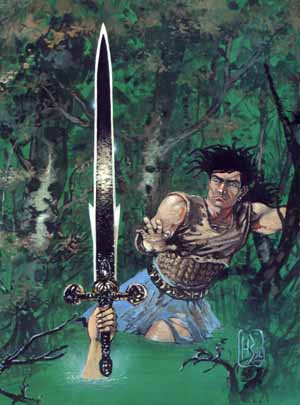 French,
translated into Dutch as De Legende van Kynan.
French,
translated into Dutch as De Legende van Kynan.
Written by Jean-Luc Sala, illustrated by Henri Joseph Recule. Published by Lombard. (Source for French publication information: Bedetheque.)
Robert Vermaat writes: "In a very mythical (and violent) story, Jean-Luc Sala and illustrator Henri Recule have recreated the foundation-legend of Brittany. Kynan, lord of Meriadawg (the original Conan Meriadoc) is a fifth-century warlord from Wales, who follows Mac Sen (the usurper Magnus Maximus, a.k.a. Maxen Wledig) on his conquest to Rome. With the help of the Goddess and the sword Kaledvoulc'h (Excalibur), he can win the Cauldron of eternal Life to stop Mac Sen in his evil plans. The tyrant is killed in Rome, after which Kynan can rule Armorica and serves Arthur."
Written and illustrated by various. Black and white. Caliber
Comics, 1999 - 2000.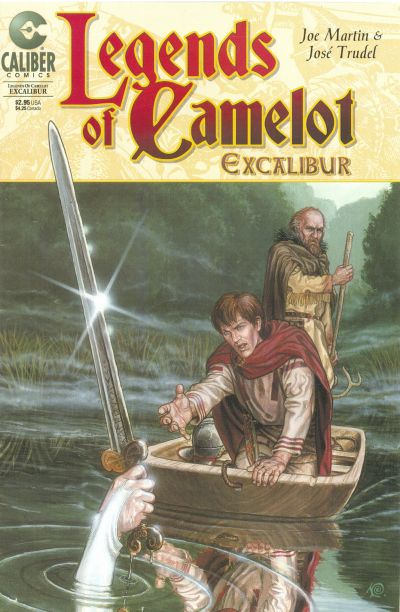
This was an ongoing series of stand-alone adaptations of episodes from Arthurian legend. The issues published included Legends of Camelot: Excalibur, retelling the story of Arthur's acquiring his sword from the Lady of the Lake; Legends of Camelot: Quest for Honor, relating the lesser-known tale of Gereint and Enid; Legends of Camelot: Merlin, relating the events of Merlin's boyhood; and Legends of Camelot: Sir Balin and the Dolorous Stroke. Another issue, entitled Legends of Camelot: The Enchanted Lady, featured an original story with an Arthurian setting rather than a retelling, and is discussed in Part Two.
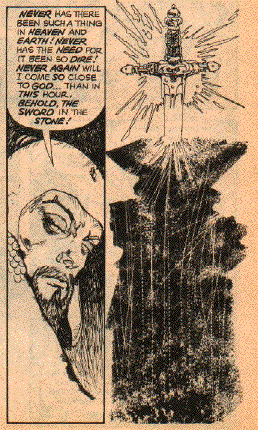 Written by
Budd Lewis, illustrated by Esteban Maroto (issue #67) and Gonzalo
Mayo (#74). Black and white. Warren Publishing, 1975-1976.
Written by
Budd Lewis, illustrated by Esteban Maroto (issue #67) and Gonzalo
Mayo (#74). Black and white. Warren Publishing, 1975-1976.
Only two chapters of this generally entertaining, somewhat irreverent, occasionally gruesome account of Merlin's efforts to get Arthur conceived, born, and raised to his kingship were published. Maroto's artwork is especially distinctive. (Lewis wrote a sequel of sorts, "Cagim", for later issues of Eerie.)
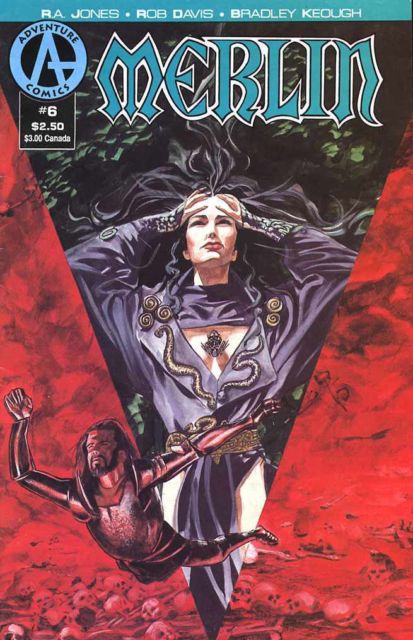 (Adventure Comics)
(Adventure Comics)Written by R. A. Jones, illustrated by Rob Davis (penciller) and Bruce McCorkindale (inker). 6 issues, black and white. Adventure Comics (a division of Malibu Graphics Publishing Group), 1990 - 1991.
This miniseries, which follows the mage's career from boyhood through the birth of Uther Pendragon, includes a large amount of original material, but follows the traditional outline of the story as told by Geoffrey of Monmouth closely enough to be counted as a retelling. (A later miniseries written by Jones, Merlin: Idylls of the King, tells an original story.)
Written by Jean-Luc Istin, illustrated by Éric Lambert. Eleven volumes published from 2000 to date by Nuclea (first two volumes only) and Soleil: La Colere d'Ahes (The Anger of Ahes), L'Eveil du Pouvoir (Awakening of Power), Le Cromm Cruach, Avalon, Brendann le Maudit (Brendann the Cursed), L'Ermite et le Nid (The Hermit and the Nest), Le Chaudron de Bran le Beni (The Cauldron of Bran Beni) , L'Aube des Armes (The Morning of the Weapons), Le Secret du Codex (The Secret of the Codex), La Princesse d’Ys (The Princess of Ys), and Le Roi Arthur (King Arthur).
This graphic album series begins with a recounting of Merlin's conception and birth based loosely on traditional sources. The goddess Ahes attempts to renew the worship of the ancient Celtic gods with the creation of a savior devoted to the old ways. This intended savior, conceived by a spirit of the air named Elaüm on a young mortal woman named Maelle, will be named Merlin. (Sources: Bedetheque and Robert Vermaat.)
Related works written by Istin include Merlin: La Quete de l'Epée, Merlin le Prophète, and Arthur Pendragon.
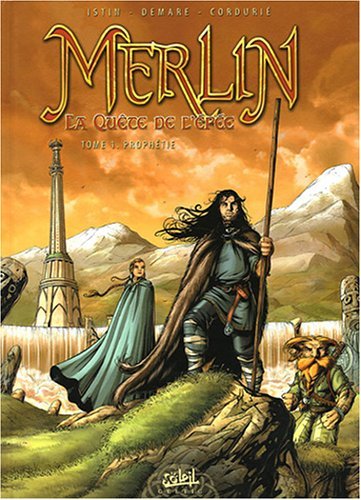
French
Written by Jean-Luc Istin, illustrated by Demare. Five volumes published by Soleil, 2005-2012: Prophétie ( Prophecy), La Forteresse de Kunjir (The Fortress of Kunjir), Swerg le Maudit (Swerg the Cursed), Mureas, and Les Dames du Lac de Feu (The Ladies of the Lake of Fire).
The author of the graphic album series Merlin
and Arthur Pendragon
tells the story
of Merlin's search for Excalibur and his preparing the way for the
coming of Arthur. (Sources: Bedetheque and French Wikipédia.)
Written by Jean-Luc Istin, illustrated by Pierre-Denis Goux and Bojan Vukic. Four volumes published from 2010 to date by Soleil: Hengist, Renaissance, Uther, and L'Ame du Monde (The Soul of the World).
This series, written by the prolific author of Merlin, Merlin: La Quete de
l'Epée, and Arthur Pendragon,
focuses on Merlin's exploits in the generation before Arthur, as
Vortigern rises to power and the Saxons invade Britain. (Sources:
Bedetheque and Amazon.fr.)
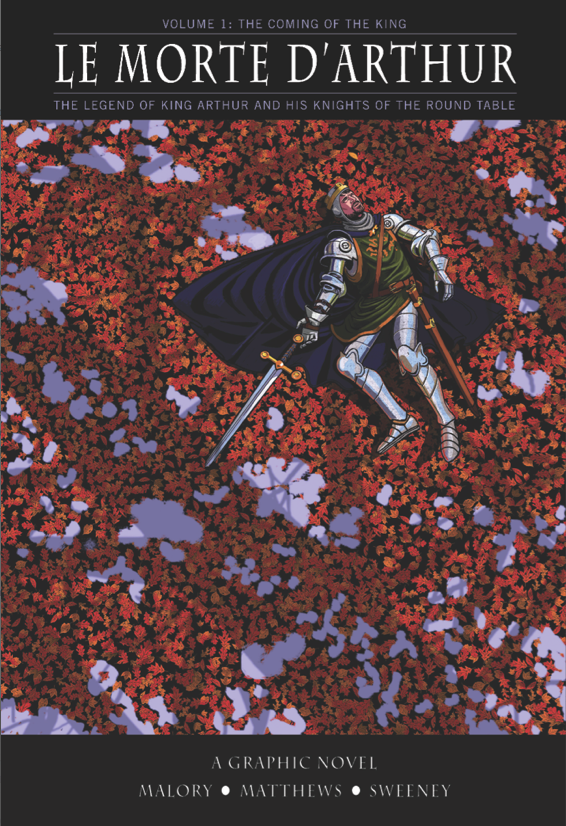 Original
text by Sir Thomas Malory, adapted by John Matthews (writer) and Will
Sweeney (illustrator). One volume (to date), The Coming of the King, published by SelfMadeHero, 2011.
Original
text by Sir Thomas Malory, adapted by John Matthews (writer) and Will
Sweeney (illustrator). One volume (to date), The Coming of the King, published by SelfMadeHero, 2011.
While many comics retellings of the Arthurian legend are substantially based on the work of Sir Thomas Malory, this adult graphic novel is distinctive in presenting itself as a literal comics adaptation of the first part of Le Morte d'Arthur, to the extent of giving Malory's name precedence as its primary author. However, while it includes considerably more plot details than many other comics versions of Malory (most of which are aimed at young readers), and is franker in its portrayal of violence and sexuality, the work still feels like a rather superficial recounting of the legend, especially in comparison to its monumental source. (The industrious Matthews has also scripted another Arthurian graphic novel, The Chronicles of Arthur: Sword of Fire and Ice, discussed above.)
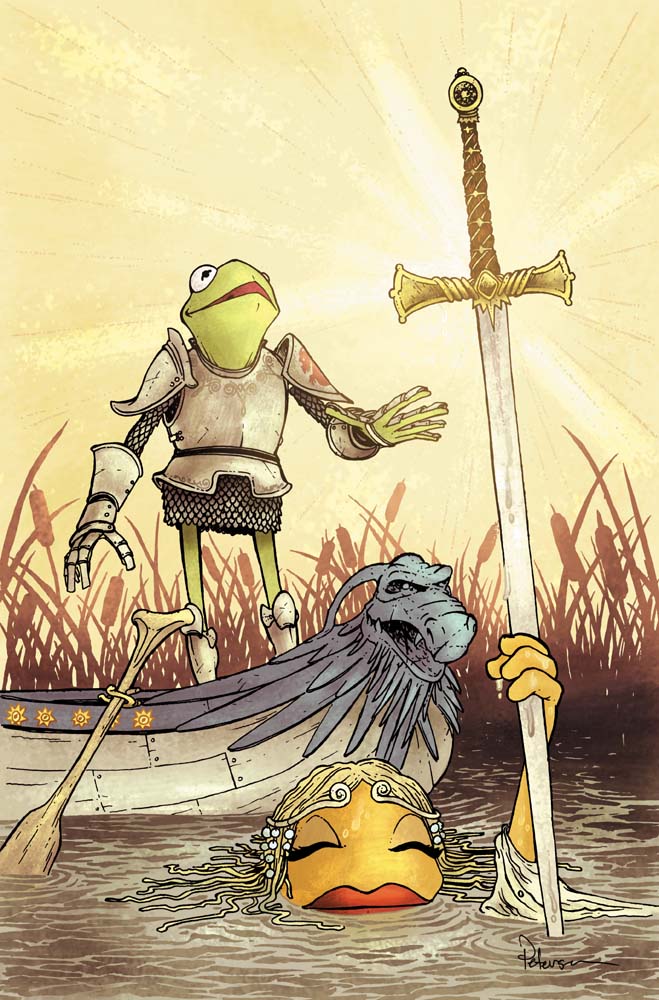 Wriiten
by Paul Benjamin and Patrick Storck, illustrated by Dave Álvarez
and James Silvani. Four issues, BOOM! Studios, 2010; collected in
trade paperback, also 2010.
Wriiten
by Paul Benjamin and Patrick Storck, illustrated by Dave Álvarez
and James Silvani. Four issues, BOOM! Studios, 2010; collected in
trade paperback, also 2010.
French, translated into Dutch as Op Zoek
naar het meisje met
het Gouden Haar. 
Written by Xavier Josset and Maurice Pommier, illustrated by
F.
Bihel. First published in the magazine Hello Bédé #61
(1990) and subsequent issues; also published in book form by Lombard in
1991. (Source for French publication information: Daniel Nastali.)
Robert Vermaat describes this as an "'ethnic' adaptation of the Tristan & Iseult legend... In this single album... [the creators] retell the story of the birth of Tristan, his youth and the incidents that lead him to Ireland to bring Isolde (Iseult) back home to become the wife of his uncle. The story ends with the boat nearing the Cornish coast, with Tristan and Isolde having become lovers.
"The scene is very ancient Celtic and pagan, but this does not upset the story. I like the original points in the plot, such as the 'sea-monster' that Tristan has to kill: instead of something unrealistic, the writers chose an Orca!"
Italian.
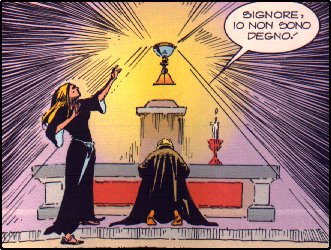 Written
by Roudolph and Corrado Blasetti, illustrated by Alessandro
Chiarolla. Produced by Periodici San Paolo S.r.l. - via Liberazione
4, -12051 Alba. Published as a supplement to the magazine Il Giornalino n.35,1994.
Written
by Roudolph and Corrado Blasetti, illustrated by Alessandro
Chiarolla. Produced by Periodici San Paolo S.r.l. - via Liberazione
4, -12051 Alba. Published as a supplement to the magazine Il Giornalino n.35,1994.
Daniel Nastali provides the following annotation to this work: "In this comic book supplement to the magazine Il Giornalino, Percival is put through a series of fantastic adventures as he seeks the Graal, which in the end cures a disease the young knight has contracted, destroys Klingsor, and wins the hero a place among Artu's company. The story was reprinted in book form as La leggenda del santo Graal by Edizioni San Paolo (1996). The book includes another story which probably also first appeared in Il Giornalino, "Ser Lancillotto", a fantasy adventure in which the knight and Uwain help recover Excalibur from an evil sorcerer. Arthur, at one point, is transformed to a crow.
"The same writers and artist previously produced other Arthurian
stories for the same magazine #33 (1993). Collected in book form as King Arthur: A Fumetti,
the stories were: "Excalibur", how Arthur obtained his sword from the
Signora del Lago; "L'erede sconosciuto", the origin of Arthur and the
sword in the stone; and "Lady Ginevra", how Arthur won his bride and
the Round Table."
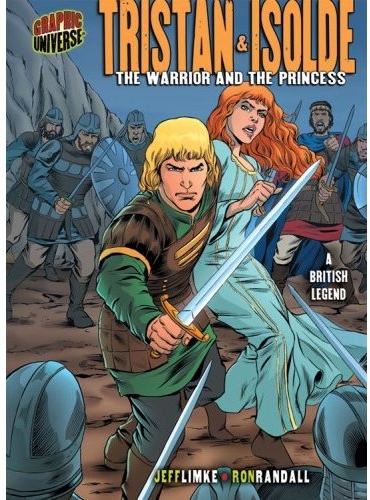
Illustrated by Bo Hampton and written by Dan Abnett . One paperbound volume (also available as a signed and numbered hardcover), NBM Publishing Co., 1994.
This intriguingly-titled graphic novel was apparently originally intended as the first of a series of volumes retelling the entire Arthurian legend. The events of Vortigern's ascension and fall, the coming of Merlin, and the birth of Arthur are recounted in first person by a dying Uther Pendragon. The scripter, Dan Abnett, is also the co-creator of the Knights of Pendragon.